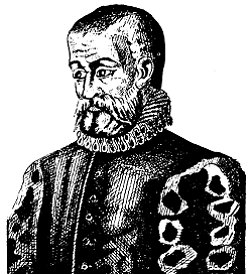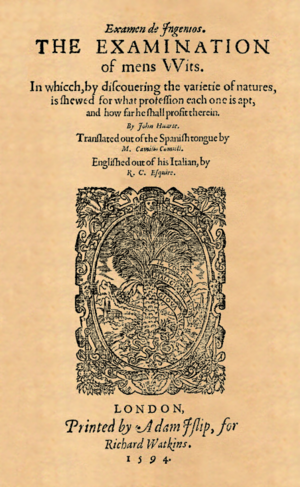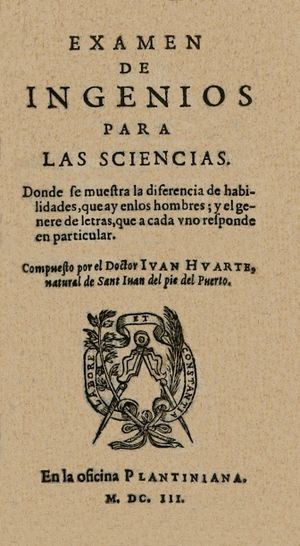Juan Huarte de San Juan facts for kids
Juan Huarte de San Juan (born 1529, died 1588) was a Spanish physician and psychologist. He wrote some of the very first books about psychology, long before it became a modern science in the 1800s.
Contents
About His Life
Juan Huarte de San Juan was born in a place called Saint-Jean-Pied-de-Port in 1529 or 1530. He first studied at the University of Huesca. Later, he went to the University of Alcalá, where he earned his degree in medicine in 1560.
Juan Huarte was known for his medical skills. He helped many people during a terrible plague that hit Baeza in 1566. For a short time in 1573, he worked as a doctor for the local church leaders. However, he was let go after six months. This happened because he left his job without asking for permission. He wanted to get special approval to print his most important book, Examen de ingenios para las sciencias, which means "The Examination of Men's Wits."
In his personal life, Juan Huarte married a woman named Águeda. They had three children together: Antonia, Águeda, and Luis.
Juan Huarte de San Juan passed away in Linares in 1588.
His Important Book
Juan Huarte published the first version of his famous book, Examen de ingenios para las ciencias, in 1575. This book became very well-known across Europe. It was even translated into many languages, including by the famous writer Gotthold Ephraim Lessing.
Even though some authorities, like the Inquisition, initially tried to stop its spread, copies of Examen were found in many libraries. Huarte's book is important because it was one of the first to connect psychology (how our minds work) with physiology (how our bodies work). It showed very clever and bold ideas for its time.
After Juan Huarte died, a second version of his book was published. This version had been reviewed and changed by the Inquisition. Between 1575 and 1800, the Examen was printed sixty different times! It was translated into six European languages: French, Italian, English, Latin, German, and Dutch. The English translation was done by Richard Carew.
His Theories
In his book Examen de ingenios para las ciencias, Juan Huarte shared several interesting ideas about people's abilities and differences.
Understanding Talents
Huarte believed that each person usually has one main talent, rather than many different ones. He thought this special talent was unique to each person and even to different countries.
He also stressed how important it is to choose a job or profession that matches a person's natural talent. If someone tries to learn a science or skill that doesn't fit their "genius" or natural ability, Huarte believed they would struggle.
Finally, he thought that each talent was connected to a person's temperament, which was linked to their physical body. This idea connects to his theory about "humoral temperaments."
Learning for Children
Huarte also wrote about how children should be taught based on their abilities. Since he believed children had different single talents, he thought they should be studied when they are young. This way, teachers could figure out their strengths and help them learn most effectively in those areas.
He knew that learning tasks needed to be right for a child's age. For example, he thought children should learn language when they are very young. More complex subjects like logic would be better for when they are older.
Humoral Temperaments
Huarte believed that different levels of "humors" in the body (like heat, cold, wetness, and dryness) caused differences in people. This was a common idea in medicine at the time. He applied this idea to explain differences in memory and understanding.
He thought that memory was better when the brain was "moist," and understanding was better when the brain was "dry." So, he believed older people had "dry" brains, which meant they had good understanding but poor memory. Children, on the other hand, had "moist" brains, which helped with memory but meant they had less understanding. Huarte even suggested that memory is better in the morning because our brains get "moist" while we sleep and "dry out" during the day.
Behavior and the Brain
Juan Huarte thought that our behavior was largely shaped by our brains and bodies. He was interested in how natural things about us affect how we act. This made him an important early thinker in the field of differential psychology, which studies how people are different from each other.
Views on Gender
During Huarte's time, views on women were often not very positive. Huarte's theories, based on his ideas about "humoral temperaments," reflected these common beliefs. He suggested that women were "cold and dry," which he linked to certain characteristics. Today, we know these ideas are not accurate. However, historians study these views to understand how thinkers in the past sometimes supported social norms of their time.
His Impact
In 1983, Juan Huarte de San Juan was honored as the official patron (or protector) of Spanish psychology. His book, Examen de ingenios para las ciencias, is seen as a very important early work in many areas. These include organizational psychology, how we assess people's abilities, and even how language works. Some experts even suggest that Huarte might have been the first person to study neuropsychology, which looks at how the brain affects behavior.
In the 1500s and 1600s, Examen was considered one of the best medical books available. Juan Huarte's ideas influenced many famous thinkers, even if they didn't always mention him directly. These include Miguel de Cervantes (who wrote Don Quixote), Francis Bacon, Immanuel Kant, and Noam Chomsky.
His work also helps us understand that the Renaissance was a time when men made many intellectual advances, but women often did not have the same opportunities.
Images for kids
See also
 In Spanish: Juan Huarte de San Juan para niños
In Spanish: Juan Huarte de San Juan para niños







